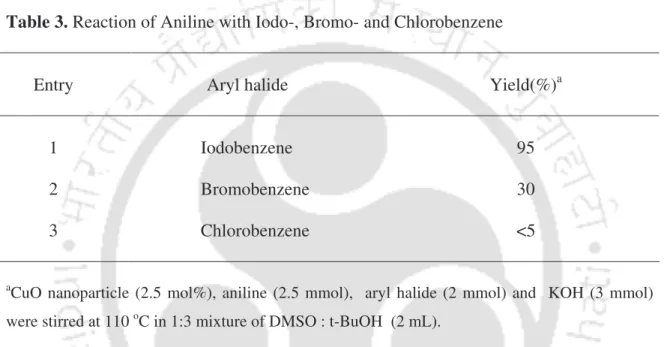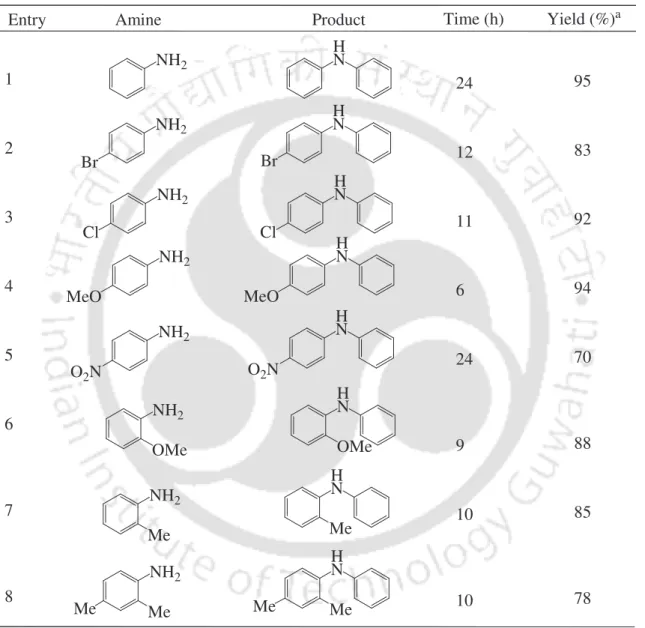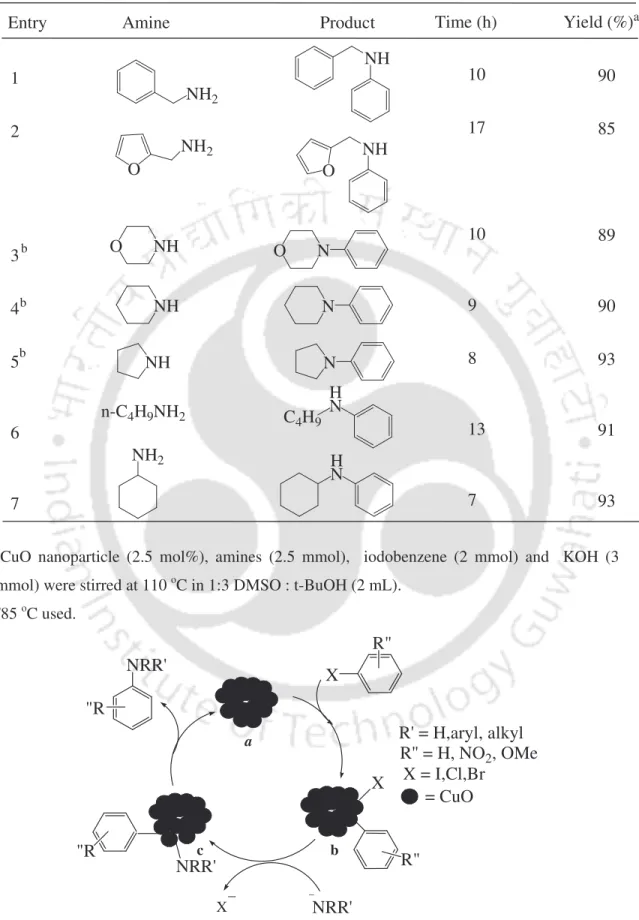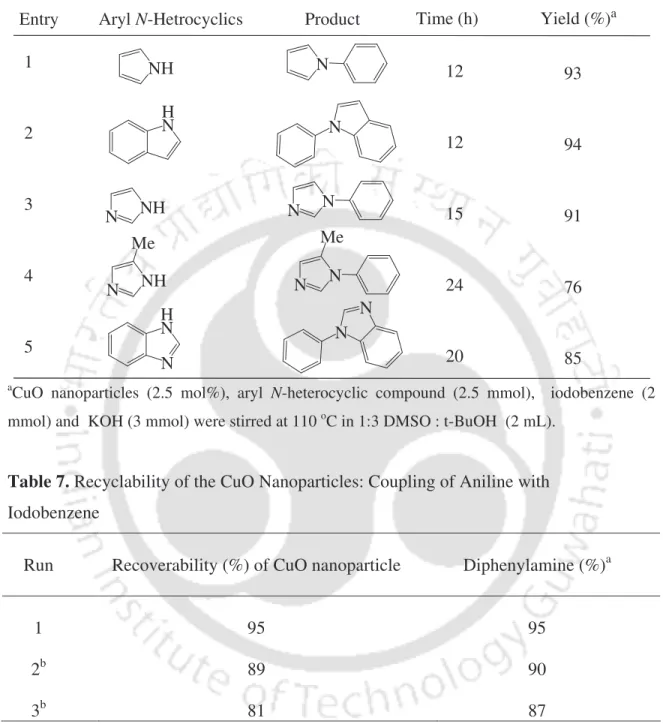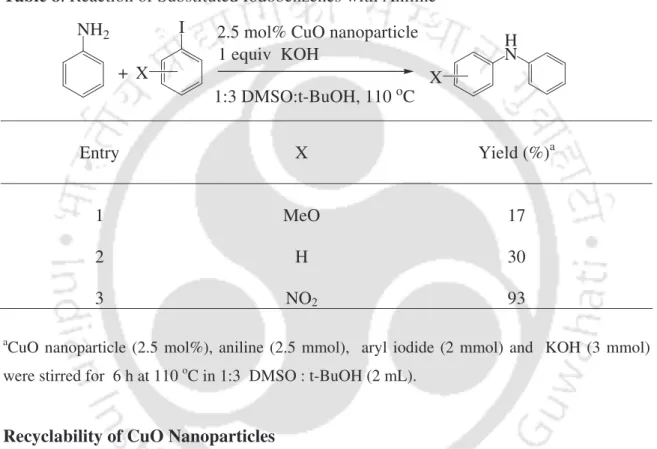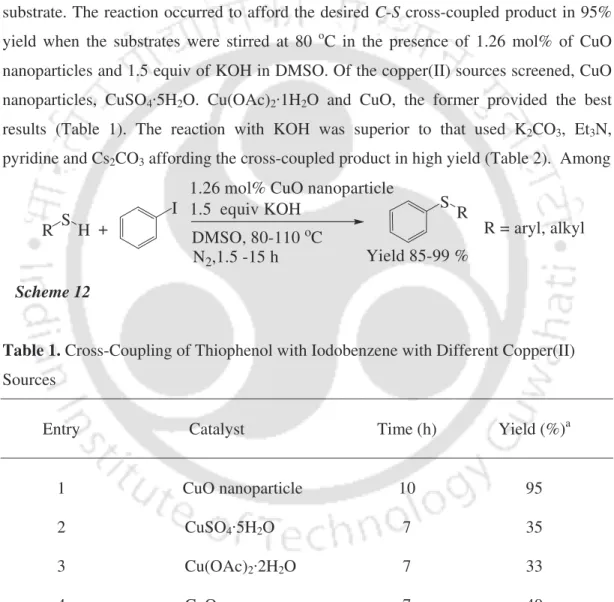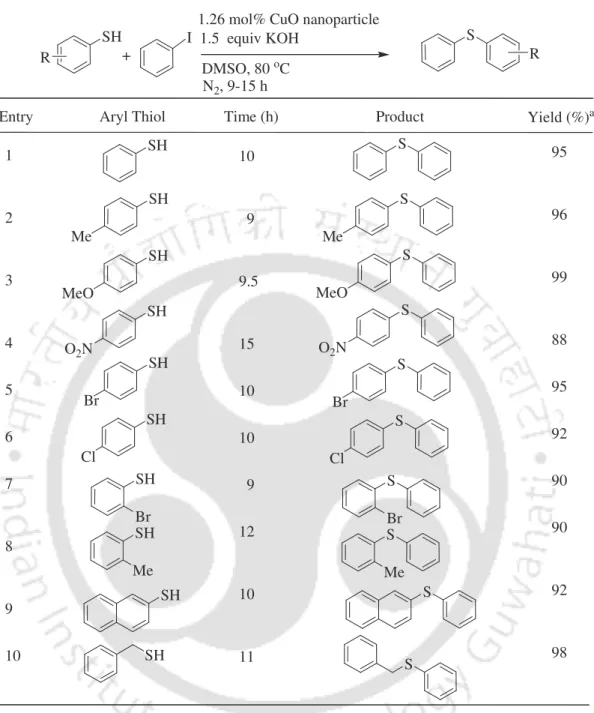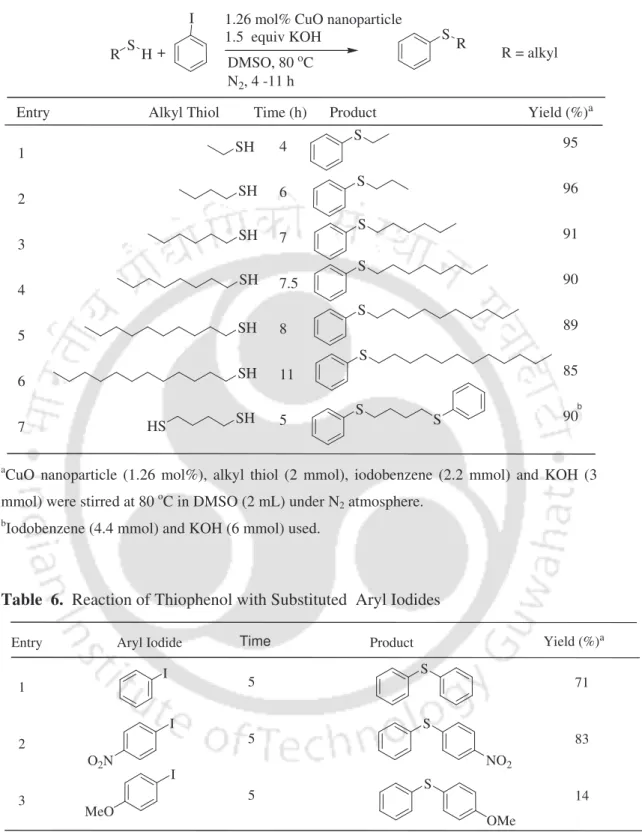The formation of C–N bonds by cross-coupling reactions represents powerful means for the preparation of numerous compounds in biological, pharmaceutical, and material sciences. This chapter elaborates on the use of CuO nanoparticles for the amination of aryl iodides (Scheme 1). Transition metal-catalyzed formation of C-O bonds in cross-coupling reactions constitutes a powerful method for the preparation of these compounds.
Arylation of Aryl Iodides with Nitrogen Nucleophiles
Present Study
First, the reaction of aniline with iodobenzene was investigated as a standard substrate to optimize the reaction conditions. To study the scope of the procedure, the reaction of arylamines with iodobenzene was next studied (Table 4). It was, after vacuum drying, reused for the fresh reaction of aniline with iodobenzene for three recycling cycles.
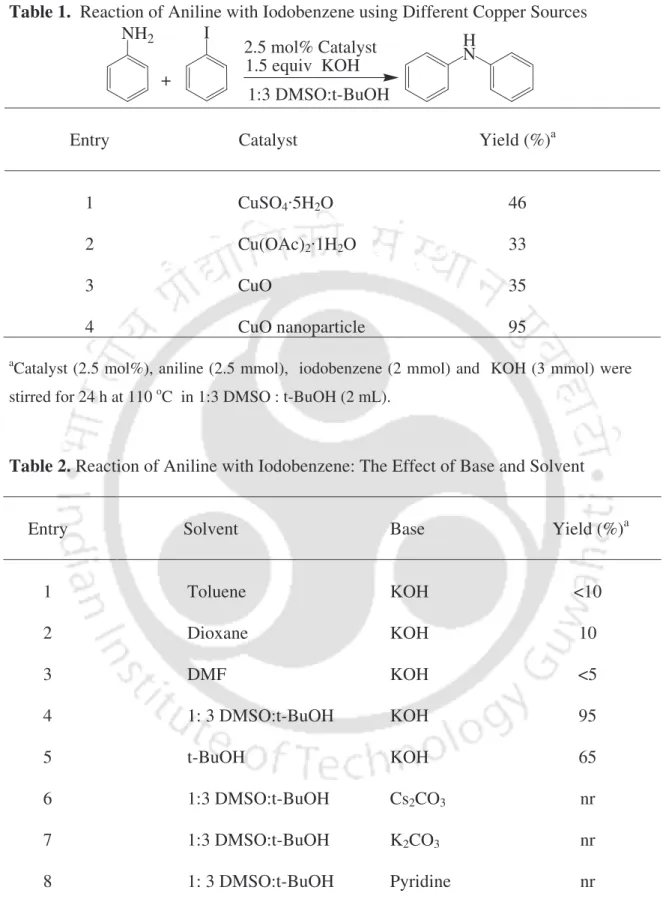
Arylation of Aryl Halides with Sulfur Nucleophiles
The coupling of aryl chlorides and bromides with thiols is subsequently investigated using palladium(II) complex 1 in the presence of NaOt-Bu (Scheme 3).4a These reaction conditions are also suitable for reactions of aryl halides with amines and alkenes. Itoh and Mase reported the cross-coupling of thiols with aryl bromides by the combined use of Pd2(dba)3 and xantphos 2 in the presence of i-Pr2NEt in 1,4-dioxane.
Scheme 4
Present Study
- CuO Nanoparticle Catalyzed Reactions
- C-S Cross-Coupling Using CuI/TBAB in Water
This section describes C-S cross-coupling of aryl halides with thiols using CuO nanoparticles8 and CuI/TBAB systems. The reaction conditions were optimized by studying the coupling of thiophenol with iodobenzene as a model substrate. These reaction conditions were also suitable for the cross-coupling of alkyl thiols with iodobenzene (Table 5).
Ethyl, butyl, hexyl, octyl and dodecyl thiol reacted with iodobenzene to give the cross-linked products in 85-96% yield. In the case of butane-1,4-dithiol, both SH groups cross-coupled with iodobenzene in 90% yield. It was reused for the fresh reaction of thiophenol with iodobenzene and the reaction proceeded to give the desired diphenyl sulfide.
In summary, the C-S cross-coupling of aryl and alkyl thiol with aryl iodides is accomplished using CuO nanoparticles under moderate temperature. This section focuses on C-S cross-coupling of aryl and benzyl thiols with aryl halides using CuI in the presence of TBAB in water (Scheme 13).10. First, the reaction of thiophenol with iodobenzene as a model substrate was studied to optimize the reaction conditions.
Reaction of thiophenol with iodobenzene: Effect of base temperature and temperature input.(oC) Time (h) Yield (%)a.
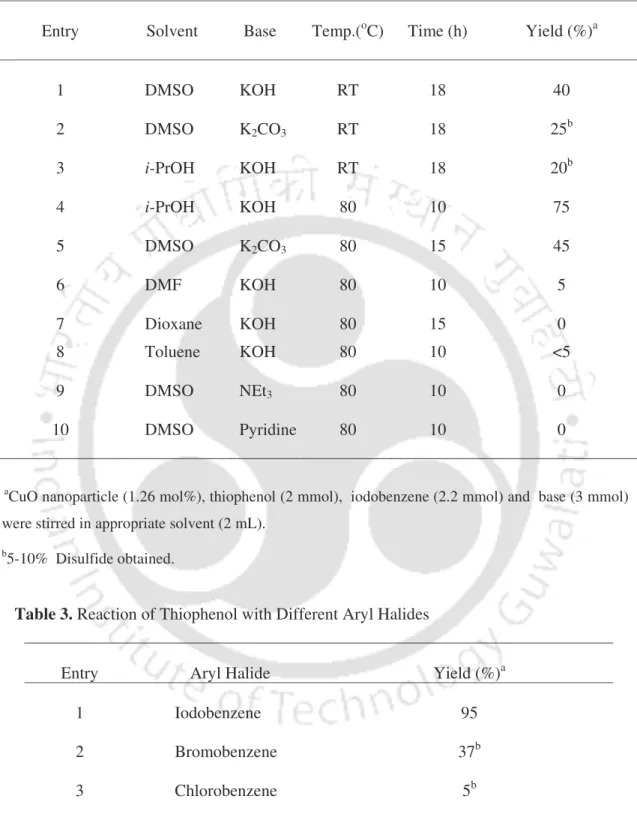
Mechanism
The reaction with 1-iodo-4-nitrobenzene gave the product in 95% yield, while the reactions of 1-iodo-4-methoxybenzene and 1-iodo-2,4-dimethylbenzene required 12 h to provide the cross-coupling products in 75% and 85% yield , respectively. These results suggest that the reaction occurs by oxidative addition followed by reductive elimination processes (Scheme 14). The oxidative addition of the aryl halides with catalyst a can give intermediate b, which can react with thiol to give intermediate c.
Intermediate c can provide a C-S cross-coupling product by reductive elimination, where TBAB presumably acts as a phase transfer catalyst and solubilizes organic substrates in water. In summary, the C-S cross-coupling of thiols with aryl halides is accomplished using CuI in the presence of TBAB in water. Aryl and benzyl thiols are more reactive compared to alkyl thiols, giving C–S cross-coupling products in high yields.
The organic and aqueous layers were separated and the aqueous layer was extracted with ethyl acetate (5 mL). Drying (Na 2 SO 4 ) and evaporation of the solvent gave a residue which was passed through a short pad of celite to give analytically pure C-S cross-linked product. The reaction mixture was then cooled to room temperature and treated with diethyl ether (10 mL).
Drying (Na2SO4) and evaporation of the solvent under reduced pressure provided a residue which was passed through a short pad of silica gel using ethyl acetate and hexane as eluent to provide an analytically pure C-S cross-linked product.
Arylation of Aryl Halides with Oxygen Nucleophiles
Hartwig and Mann reported the coupling of aryl alkoxides with aryl bromides using Pd(dba)2 and CF3-dppf2 [dppf =1,1'-bis(trifluoromethyl)phenylphosphinoferrocene)]. These authors also further demonstrated the coupling of aryl alkoxide with aryl bromide using Pd(dba)2-P(t-Bu)3 in toluene (Scheme 4).6c Under these conditions, aryl chlorides undergo reactions more efficiently compared to aryl bromides and – iodides at moderate temperature. Buchwald and co-workers demonstrated the cross-coupling of phenols with aryl halides by the combined use of Pd2(dba)3 and electron-rich and bulky aryldialkylphosphine 3 in the presence of NaH or K3PO4 in toluene (Scheme 5).6d. coupling of aryl chlorides, bromides and triflates has been demonstrated in high yields.
In these reactions, the size of the ligand is believed to be responsible for accelerating the rate of reductive elimination of the diaryl ether from palladium. Intramolecular C-O cross-coupling of hydroxy groups with aryl halides is achieved using Pd(dba)2-Ph5FcP(t-Bu)2.4 in toluene at ambient temperature (Scheme 6).6e Conversions of approximately 1000 are observed for reactions with unactivated aryl bromides or chlorides. More recently, the coupling of alcohols with aryl bromides using Pd(OAc)2 and ligand 5 has been reported in the presence of Cs2CO3 at 70 oC in toluene (Scheme 7).6f Under these conditions, n-butanol undergoes a reaction with 2-bromotoluene . with an efficiency of 85%.
Copper-based catalytic systems have been studied significantly for C-O cross-coupling reactions.7 Coupling of phenols with aryl iodides and -bromides is accomplished using (CuOTf)2.benzene in the presence of Cs2CO3 in toluene (Scheme 8).7a In these reactions, the acid 1-naphthoic increases the solubility of phenoxides. The use of copper(I) salt in combination with phenanthroline-based ligands 6-8 is described for the coupling of aryl iodides and -bromides with hydroxy compounds in the presence of Cs2CO3 (Scheme 9). 7b-d Aryl iodides showed greater reactivity compared to aryl bromides. Coupling of aryl iodides and -bromides with hydroxy compounds is also demonstrated using copper(I) salt and 1,3-dicarbonyl compounds in the presence of Cs2CO3 at moderate temperature (Scheme 10).7e-f These reaction conditions are also suitable. for C-N and C-S cross-coupling reactions.
Few studies show that the coupling of phenols with aryl bromides and iodides using CuI in combination with amino acid, aminophosphonate or imine as ligands in the presence of Cs2CO3 (Scheme 11).7g-i These reactions are effective at moderate temperature with high yields.
3. 2 Present Study
Synthesis, Crystal Structure and Application of Chiral
Copper(II) Coordination Polymer for Asymmetric Catalysis
Asymmetric Sulfoxidation with Aqueous Hydrogen Peroxide
The reactions using chiral complexes of Ti, V, Fe and Mn were found to be successful and provide the sulfoxides in moderate to good enantioselectivity. These reactions used various terminal oxidants such as t-butyl hydroperoxide,6a cumene hydroperoxide,6b urea hydrogen peroxide6c and iodosylbenzene.6d While the reactions with aqueous H2O2 are attractive as they generate water as a by-product only. Furthermore, aqueous H2O2 is cheaper, atom-efficient and safe to handle, making its use very attractive for "green" oxidation processes.
Di-µ-oxo titanium-salen 6 was later shown to catalyze the oxidation of aryl alkyl sulfides in the presence of 31% H2O2 at room temperature (Scheme 4). 6c These reactions provided sulfoxides up to 76% ee. Chiral vanadium-based catalysts have been extensively investigated for the oxidation of alkyl aryl sulfides with aqueous H2O2 solution. The chiral ligands 7-9 and catalyst 10 used for these reactions are summarized in Scheme 5.8 Vanadium-catalyzed systems are more efficient compared to titanium-catalyzed processes. After success with asymmetric epoxidation, chiral Mn-salen complexes are studied for asymmetric sulfoxidation of aryl alkyl sulfides (Scheme 6).9 Reactions with aqueous H2O2 are studied in CH3CN at room temperature with moderate to good enantioselectivity.
Few studies are focused on the iron-catalyzed asymmetric oxidation of arylalkyl sulfides with aqueous H2O2 at ambient temperature.10 These studies are attractive from an environmental and economic point of view. Bolm and Legros showed the oxidation of arylalkyl sulfides using ligand 12a with Fe(acac)3 in the presence of 30% H2O2 in excellent enantioselectivity (Scheme 7).10a The addition of aromatic carboxylic acids as an additive increases the enantioselectivity of the reactions. Katsuki and Egami reported the asymmetric oxidation of arylalkyl sulfides using chiral iron–salane complex 12b with 30% H2O2 in water (Scheme 8).10b These reactions efficiently catalyze the oxidation of various arylalkyl sulfides with excellent enantioselectivity and high conversion.
Chiral platinum complex, {[(R)-BINAP]Pt(m-OH)}2(BF4)2 13, is used for the oxidation of arylalkyl sulfides with 35% H2O2 in the presence of sodium dodecyl sulfate (SDS) surfactant in water (Scheme 9).11 The reactions are efficient giving the sulfoxides with high enantioselectivity and excellent turnover.
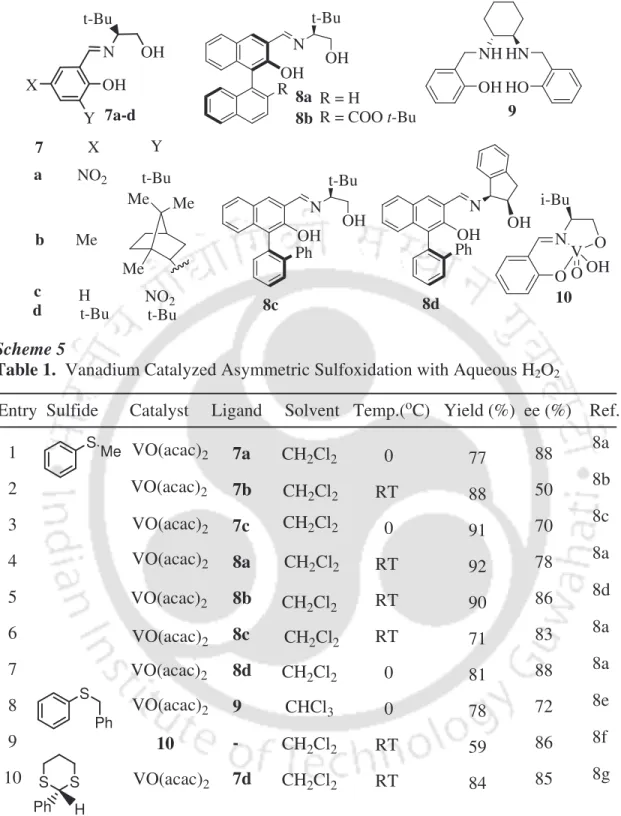
Present Study
CNCH2Cl2
- Asymmetric Desymmetrization of meso-Epoxides
- Present Study
- Asymmetric Benzoylation of Secondary Alcohols
- Present Study
- References
To study the scope of the procedure, the reaction of other alkylaryl sulfides was next studied (Table 3). The reaction of meso-epoxides with arylamines is studied by the combined use of Yb(OTf)3 and R-BINOL 14 at -78 oC in CH2Cl2 (Scheme 11).12 Both cyclic and acyclic epoxides are studied with aniline-bearing electron-donating substituents as nucleophiles. with good enantioselectivity. Few studies have focused on the use of Sc(OTf)3 with ligand 15 for the reaction of meso-epoxides with amines at ambient temperature.
These reaction conditions are also suitable for the reaction of epoxides with N-containing heterocyclic compounds. The reaction of cyclohexene oxide was first studied with aniline to optimize the reaction conditions (Table 4). The reaction was efficient at room temperature in a 1:1 mixture of water and THF compared to that of CH2Cl2, CH3CN, DMF, THF, toluene, and water.
Trost and Mino used binuclear zinc catalysts derived from ZnEt2 and ligand 20 for the resolution of 1,3-diols with high enantioselectivity (Scheme 19).19 The reaction is suitable with electron-donating phenyl rings and heteroaromatic rings. The reaction of benzoin 25 was studied as a standard substrate to optimize the reaction conditions (Table 6). The reaction proceeded to yield the desired benzoylated product at 62% ee when the reaction was allowed to stir with 5 mol% of 4 (with respect to the repeat unit) and 0.5 equiv of benzoyl chloride in the presence of Et3N at 0°C.
Further reduction of the reaction temperature to -25 oC showed enantioselectivity increase to 78% with selectivity s = 13.8. The reaction mixture was stirred at ambient temperature and its progress was monitored by TLC. Drying (Na2SO4) and evaporation of the solvent provided a residue which was purified on silica gel column chromatography using ethyl acetate and hexane as eluent.
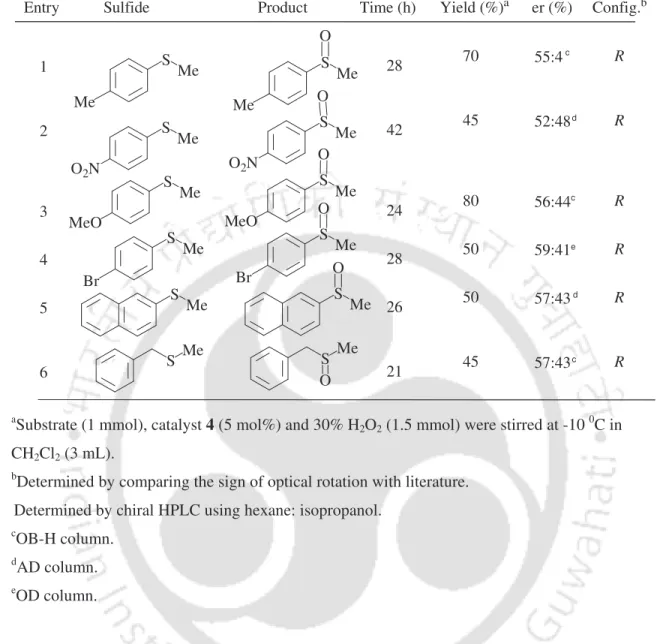
Conferences
